THE BUTT GAUGE
THE BUTT GAUGE
No, a butt gauge is not used for anatomical measurements but rather for the layout of butt hinges on doors and windows! It is a very helpful tool for that purpose.
Today we purchase doors that are prehung in their frames. It is a fairly simple task to install this type of door. If you have ever tried to install butt hinges on a door and it’s frame, however, you know how critical it is to do it right. It can be a difficult job to set the hinges without the proper experience and tools. Failure to align hinges on the door and frame will cause many problems in it’s closing and latching.
During the 19th and early 20th centuries a number of tool makers addressed this need by creating gauges specifically for the layout and installation of butt hinges. Many of these gauges received patents for their design features.
Almost any marking gauge may be used to do hinge layout but the specialty features of the butt gauge provide all the necessary settings to quickly complete the job. Butt gauges often transfer the same layout to both door and jamb without resetting the tool. Some butt gauges also have a thickness marker to set the depth of the hinge mortise.
Let’s face it, as tool collectors we also like the gadget qualities of these tools! In my gauge collection I have over twenty different butt gauges and there are others out there in the tool world that I don’t possess. Sometimes the difference between the various manufactured butt gauges is slight causing confusion about the identity of the maker. The Marden gauge shown at the bottom of Photo 1 was patented April 16, 1872 and is an example of this. This gauge is only marked occasional with the Marden name.
When encountering the “Door Hanging Gage” of Cereal LeFrancois, center of Photo 1, patented August 26, 1890, you can imagine the confusion. His gauges are never marked except for the occasional, “PATENT APL’D FOR.”
The same confusion happens when finding a George Thompson gauge, see the top of Photo 1. It was patented October 2, 1900 and was never marked except for the same notation on some examples, “PAT. APPL’D FOR.” Many of us are left scratching our heads trying to identify them. The Marden gauge shown here is trimmed with iron fittings rather than the more common brass fittings making this a rare variation. The LeFrancois seems to be the rarest gauge of the group. These three scarce gauges are very similar in appearance and function and are highly sought after by collectors. All of these gauges look great on display and with a little familiarization can be readily identified. I recommend Milt Bacheller’s book, “American Marking Gages Patented and Manufactured,” as the best source for identifying most of these tools. Although out of print, copies of his book can often be found by a search of the internet.
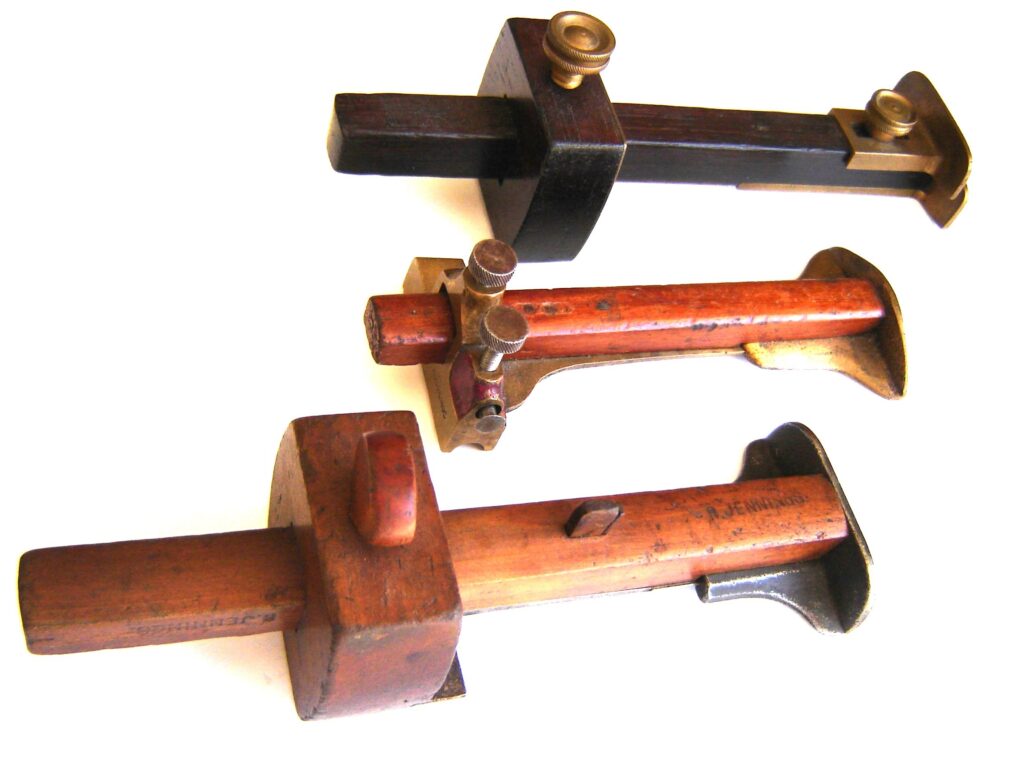
Photo 1
There are several wooden gadgety butt gauges that are as fun to operate as a Rubik’s Cube. They have various adjustments for all measurements required in hinge layout. On the right in Photo 2, the William McCullough gauge with it’s two thumbscrews, three scratch points and two arms, patented January 2, 1883 is that sort of tool. Similarly, the Henry Plante gauge on the left, patented February 23, 1886, has that same feel. Both gauges are for hinge layout only and are chunky in appearance. The McCullough is the most difficult of the two to find. I have only seen a few in sixteen years of collecting.
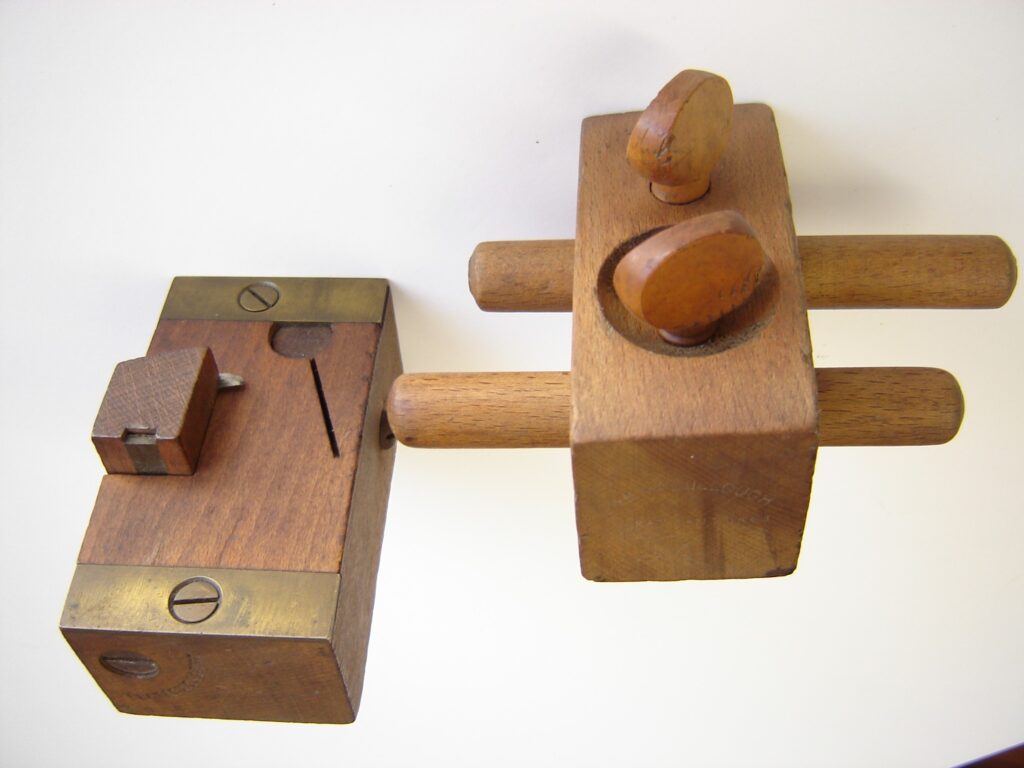
Photo 2
Horace Fulton patented his gauge on July 17, 1888, right, Photo 3. He devised a simple but efficient design of two wooden blocks that adjust laterally to effect the setup desired. It’s design was so good that sometime after 1906 the Dikeman Mfg. Co. copied Fulton’s gauge patent, feature for feature. The Dikeman, No. 75 Handy Butt Gauge, used a nickle plated casting for the lower block of the gauge and a chunk of cocobolo tropical hardwood for the top. With it’s plated & knurled adjustment wheel this gauge is a beauty. It is also very scarce! Left, Photo 3.
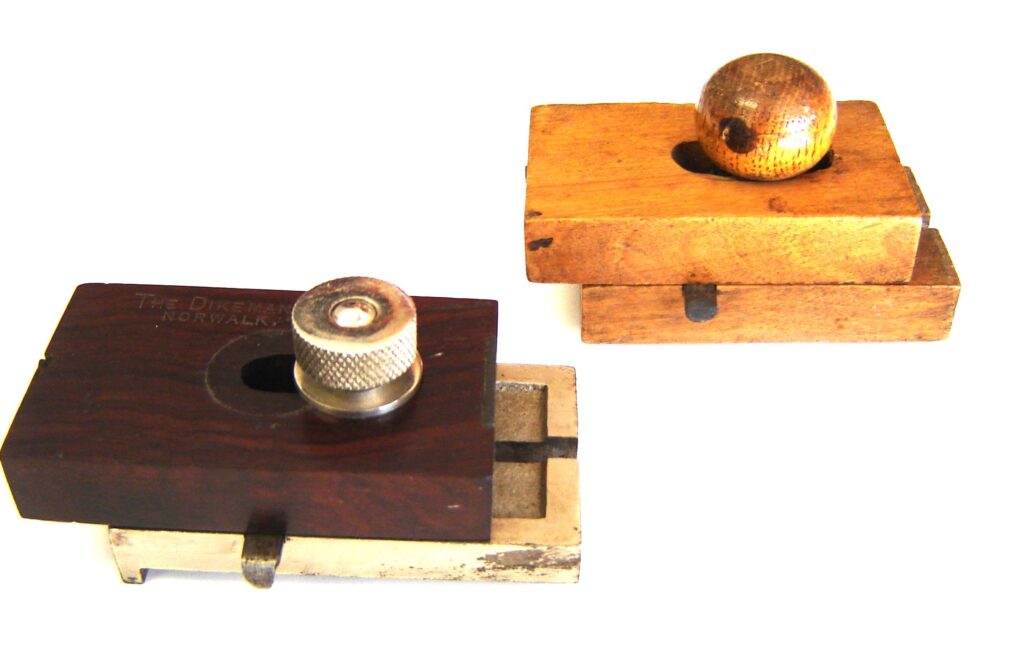
Photo 3
Stanley Rule and Level Co. made several different types of butt gauges. One is a mystery of sorts because it was never listed in any Stanley catalog. It is not marked with the Stanley name or any model number but can be identified by all the features (tells) used to identify unmarked Stanley gauges. It is at left in Photo 4. These are quite scarce and bring a good price when offered for sale. On August 23, 1892 Stanley patented the No. 92, Butt & Rabbet Gauge. It appears to be the new version of the wooden “mystery” gauge. If you like beautifully contrasted wood and brass, along with the gadget adjustments you will love this gauge shown on the right. The example here has a nickle plated beam which is much less common than the brass beam.
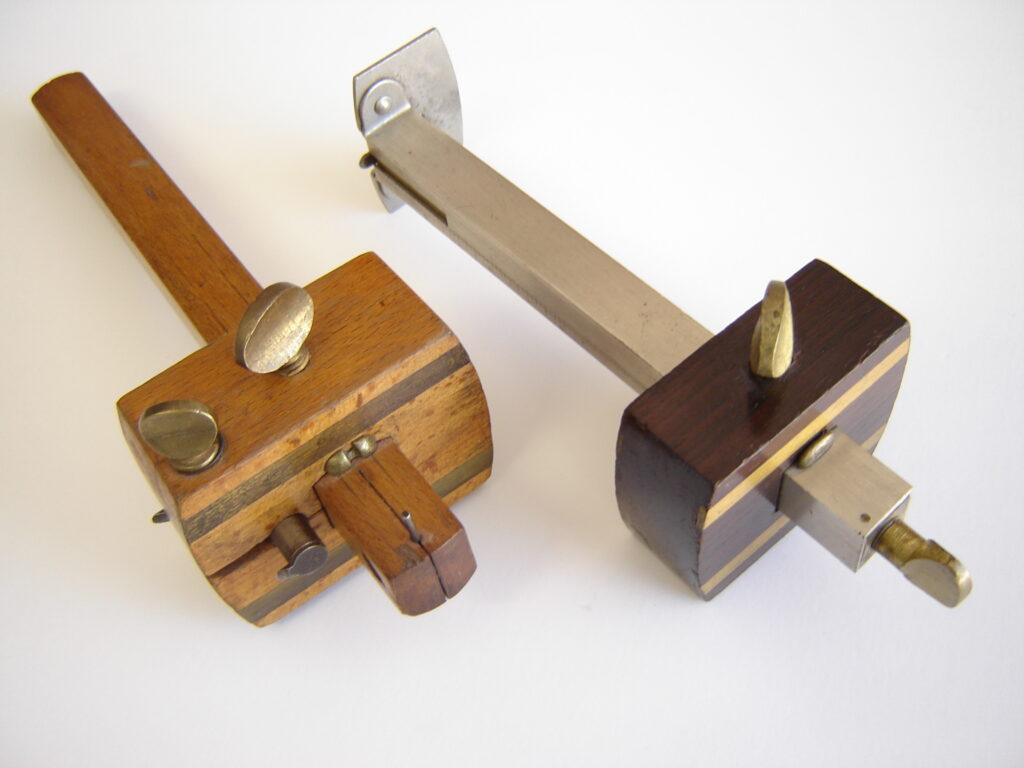
Photo 4
Stanley also made a series of nickle plated, all iron, butt gauges that were very efficient to use. The No. 95 Butt Gauge on the right in Photo 5 was introduced in 1897 and sold for almost a century. Stanley produced other variations of the No. 95; the nos. 95 ½, center & 94, left, which have slightly different dimensions but basically were the same style gauge. The No. 94 shown here is japanned rather than nickle plated because of the need for nickle in the war effort of World War II.
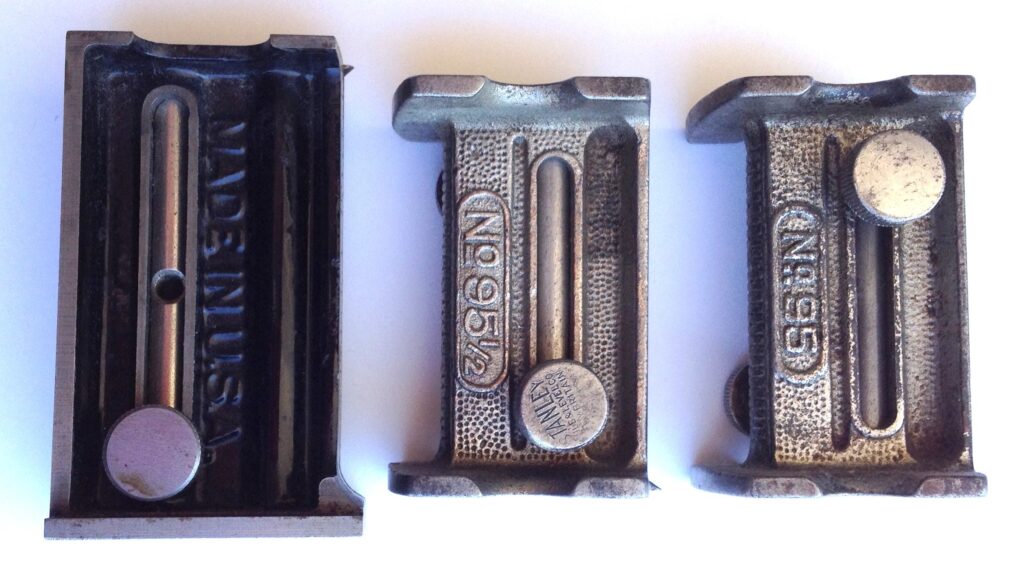
Photo 5
Stanley also manufactured these gauges for hardware companies such as Winchester, Sterns, Shapleigh, Sargent and Simmons. See Photo 6.
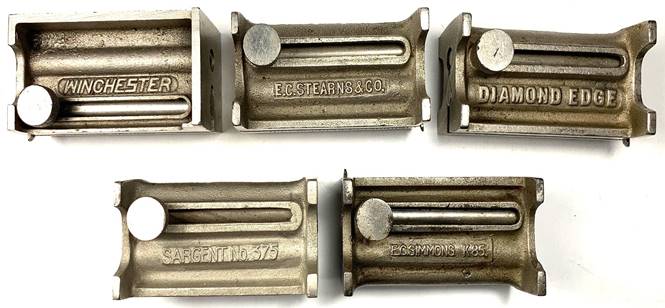
Photo 6
The General Hardware Mfg. Co., of New York City copied the Stanley style of butt gauges, making their own line as well as gauges for others, such as Montgomery Ward (Lakeside Brand) and Sears & Roebuck (Craftsman). Shown in Photo 7.
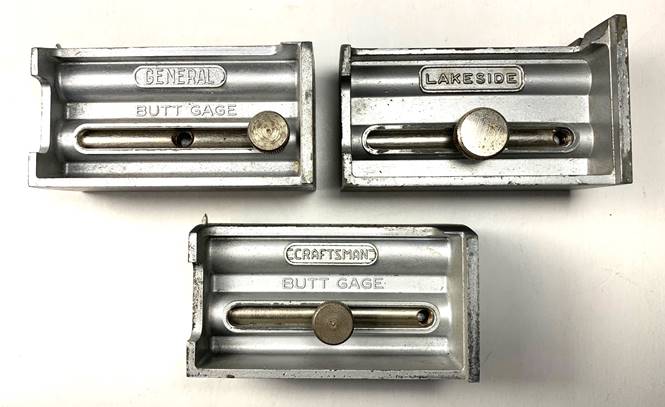
Photo 7
As you can see many butt gauges were made completely of metal. Some of these gauges do not have the beauty of wood and brass. In fact, some are downright homely. But, that’s the beauty of the genre. These gauges are functional and efficient. On the top in Photo 8, the V. B. Staples, Door Butt Gage, patented October 19, 1897, is just such a gauge. It is basically a brass rectangle with two round adjustable marking wheels. It won’t win any beauty contest but will get the job done and is rare as a hen’s tooth. When looking at the Shally Butt Gauge at the bottom in Photo 8 you see the same rectangular style but it is a more common gauge. There are also other rectangular style butt gauges available to the collector as well. Solomon said in the Book of Ecclesiastes, “There is nothing new under the sun!” And, he was correct!
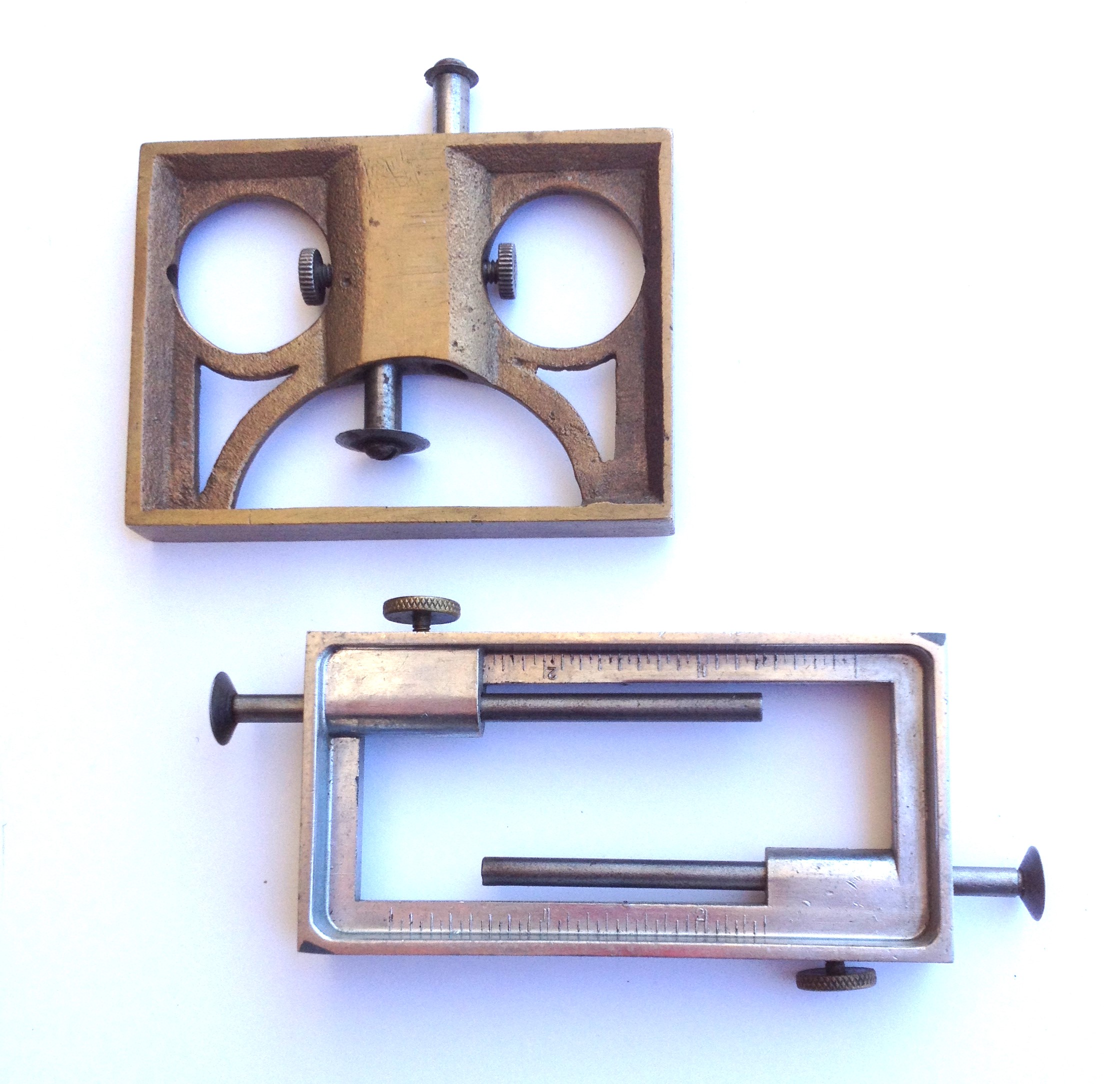
Photo 8
The next group of gauges shown is also of the all metal, gadget variety. The E. Wright, Door Hanging Gage, patented October 3, 1893, is a scarce little fellow that can do the job well and fits nicely in your pocket, right in Photo 9. A. D. Goodell designed his Combined Hinge Gage and Square and received patent 531,114 on December 18, 1894. This gauge was so popular that it was made by the Goodell Tool Co. for Miller’s Falls and Craftsman. It was sold for over fifty years and is fairly common, it is in the center of Photo 9. You can purchase one without depleting your bank account. With a little looking they can be found in good condition for your collection. Also, shown on the left but not common, is the Gelbaugh gage, patented February 2, 1904. He refined his patent several times making different varieties of his gauge to collect.

Photo 9
One prickly little gauge absolutely bristling with 8 scratch points was patented by Matthew Biersdorf in Los Angeles on June 8, 1915. It’s small enough to fit in your pocket but will surely put a hole in it. It’s got all the bells and whistles of the larger gauges for a competent layout, see left in Photo 10. An unusual gauge is the Wells & Meyer patent gauge that strikes the outline of the butt hinge in the wood. It was patented April 3, 1923 and shown on the right in Photo 10.

Photo 10
A very scarce N. A. Carping, Chicago, butt gauge has the double body wooden block construction very similar to the Fulton gauge. Have you seen one before? Patented August 8, 1905 it is on the left in Photo 11. In the same photo on the right side is a very unusual butt gauge patented by James Duffy of Seattle, Washington on October 11, 1910. It was produced by the Atkins Saw Co. It’s a strange one to me!

Photo 11
The next two gauges have a story to tell. The top gauge in Photo 12 is the Joncas gauge. Louis Joncas lived in Salem, Massachusetts. He apparently was illiterate since he signed the patent application with his ‘X.’ Oddly enough the name on the gauge itself is spelled, Goncas, a misspelling! In the bottom of Photo 12 is the Murphy gauge patented by the mechanically adept, John Murphy, who worked in the US Army, Springfield Armory, Springfield, Mass. He was credited with a number of other patents as well as this one. He was engaged to be married to the fair Mary Gertrude Murphy but died in 1904 of a cerebral hemorrhage before he could tie the knot. He was 39 years of age. He received his, ‘Gage’ patent on August 26, 1890.
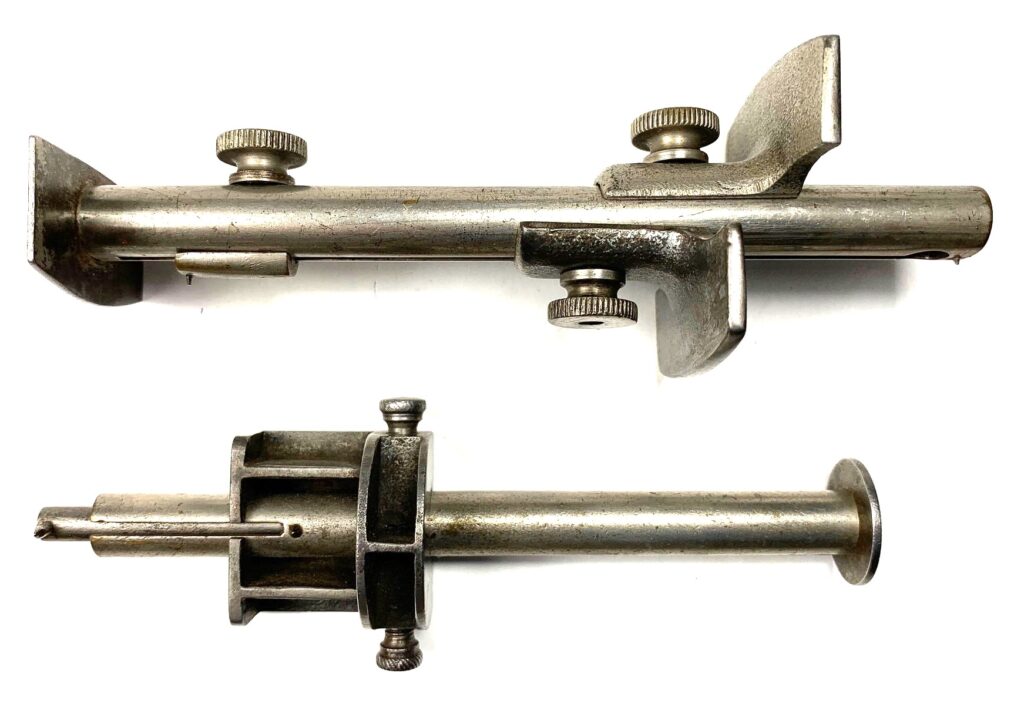
Photo 12
Butt gauges are only a small part of marking gauge collecting. The entire field has many advantages. The tools are small and require little space to display. The gauges are beautifully made with exotic hardwoods, brass and steel and, as mentioned before, they have the gadget appeal. Now, go out and ‘Kick Butt!’ Happy hunting!
Jim Fox is a retired pastor living in St. Cloud, Florida.
He can be reached at foxyjim1940@gmail.com


